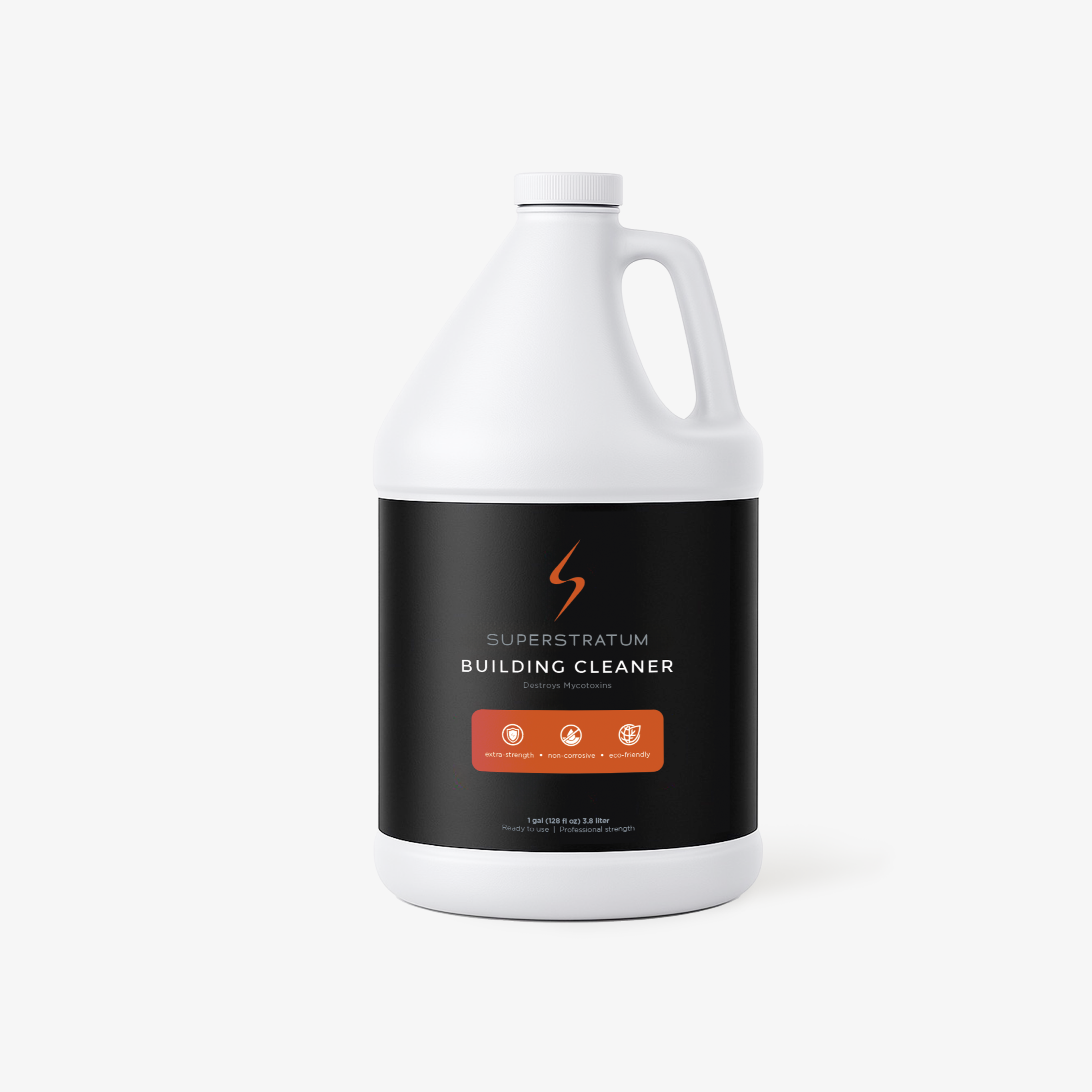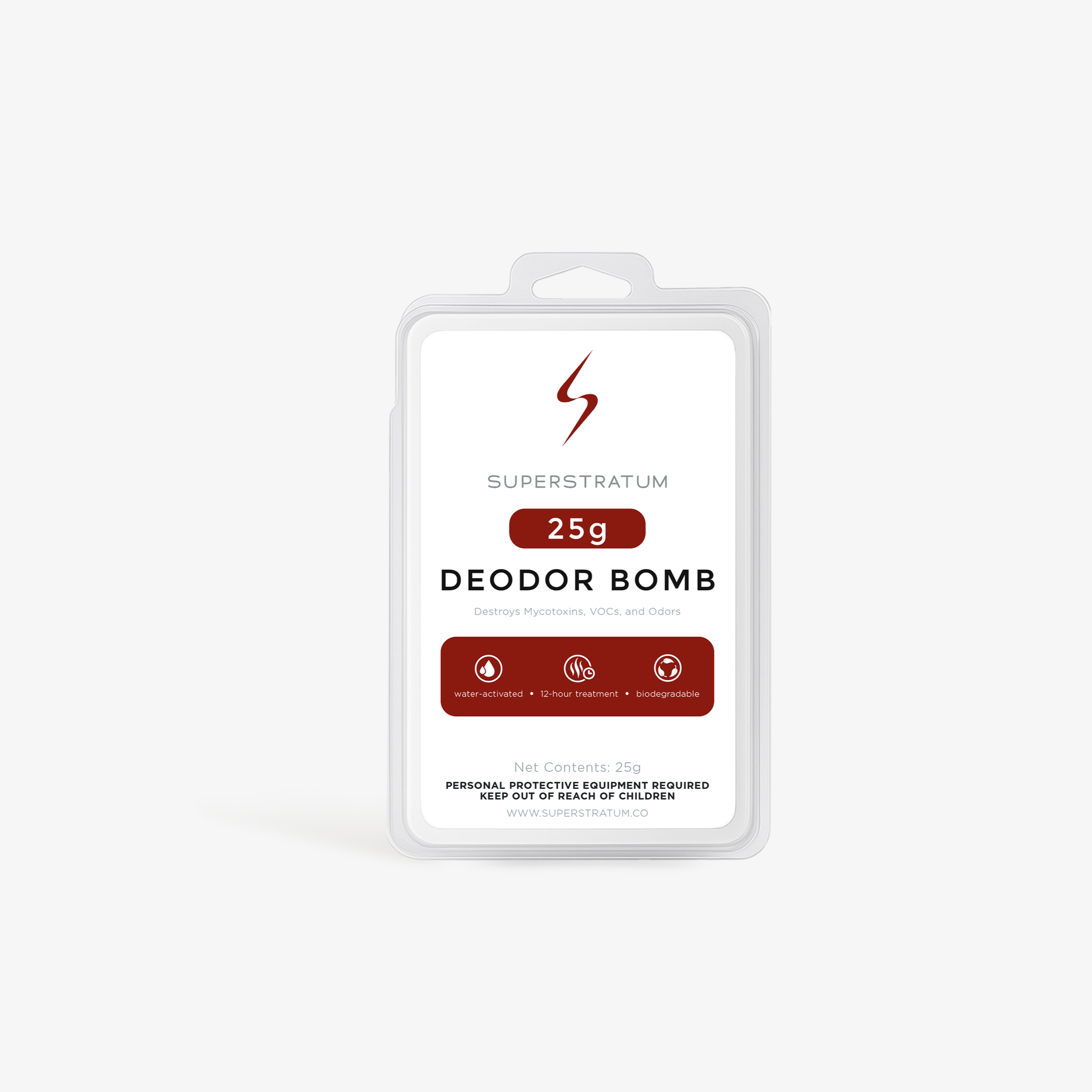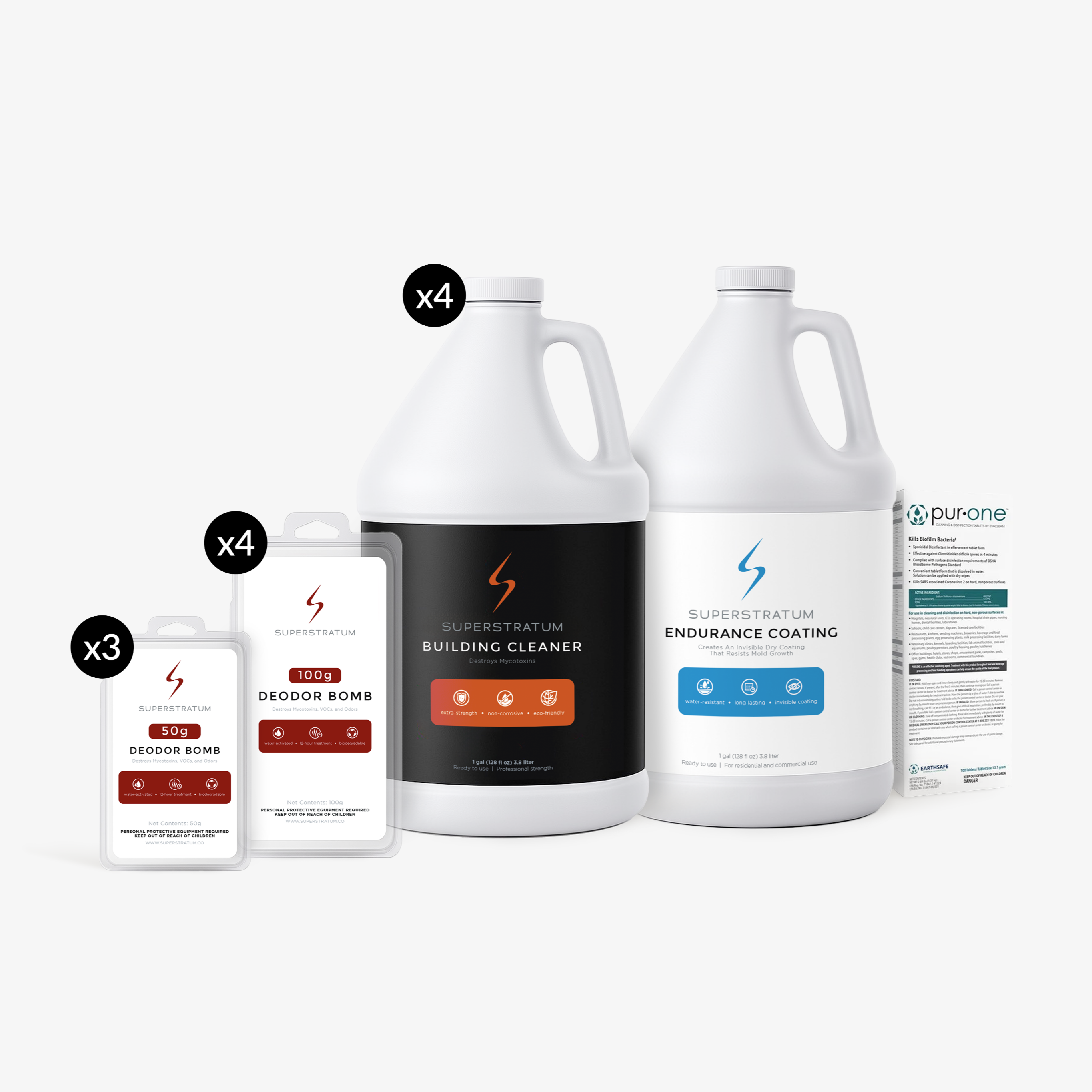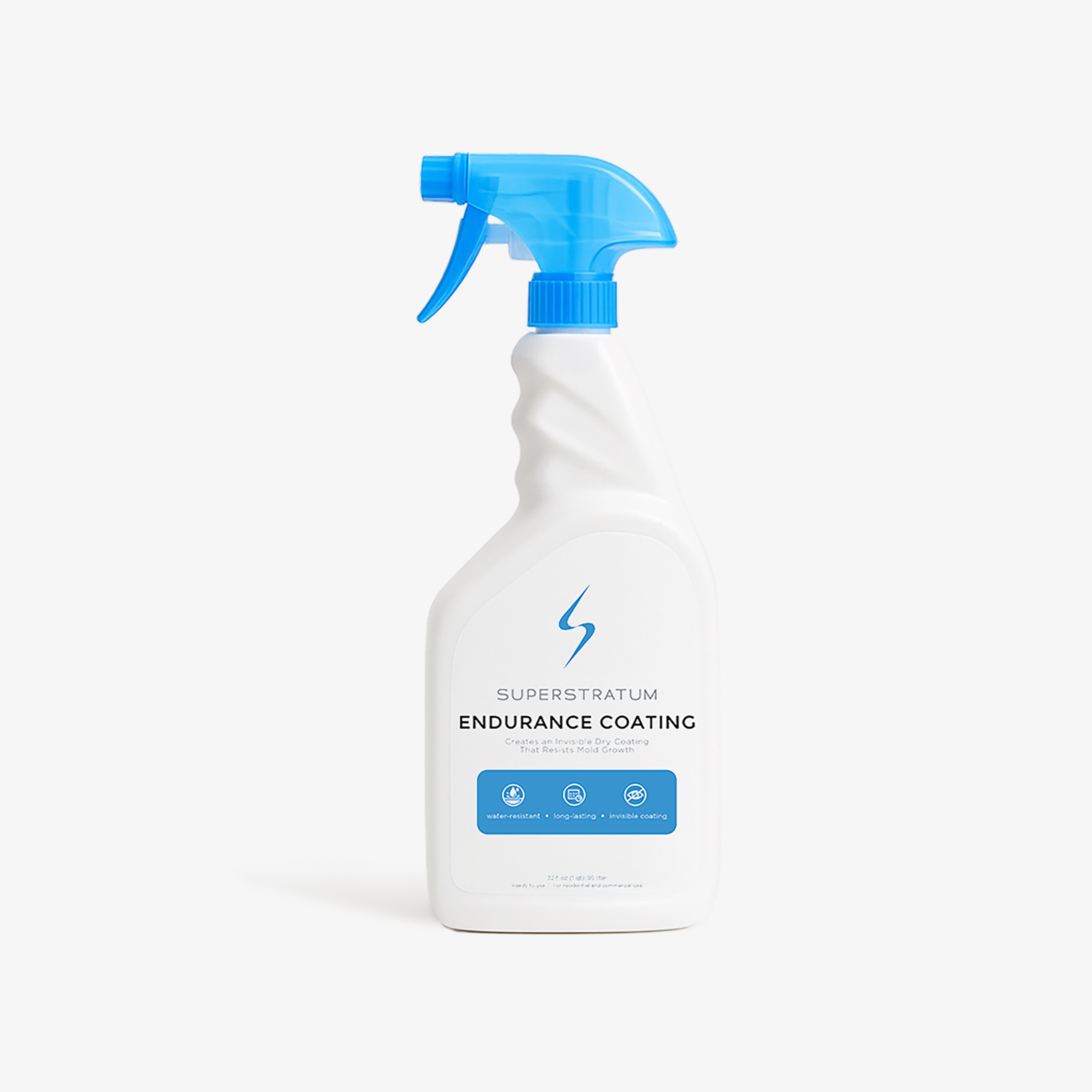
by Seth Jones
Founder & CEO || Superstratum Labs
The Hidden Problem in Homes Today
If you’re worried about the air you breathe or the safety of your home, you’re not alone.
More and more people are learning about mycotoxins—the toxic substances left behind by mold—and volatile organic compounds (VOCs), invisible pollutants that can trigger health issues ranging from allergies and fatigue to brain fog and more severe problems.
When mold grows inside a home, it doesn’t just leave visible stains or odors—it releases microscopic chemical toxins known as mycotoxins. These substances are incredibly small and can become trapped in the airtight envelopes of modern homes. Because of their size and chemical stability, mycotoxins can spread throughout an entire living space, clinging to dust, furniture, walls, and HVAC systems.
The real challenge is that traditional cleaning chemicals don’t break the chemical bonds of mycotoxins. Even after visible mold remediation, these toxins often remain behind, lingering unseen and continuing to affect indoor air quality and occupant health.
VOCs, meanwhile, come from everyday products like paints, new carpets, furniture, cleaning supplies, and building materials. They can contribute to poor indoor air quality and affect those suffering from mold or with chemical sensitivities, creating a hidden threat in homes of all ages—even brand-new ones.
As awareness grows about the dangers of mycotoxins and VOCs, many people are turning to a unique chemical called chlorine dioxide to remove them. But many homeowners have questions about ClO₂:
- Is ClO₂ safe for me and my family?
- Is ClO₂ effective at destroying mycotoxins and VOCs?
- Will it leave harmful residues behind?
- How does it compare to other products like hydrogen peroxide or bleach?
This guide will help you understand:
- What ClO₂ is and how it works
- How it performs compared to other cleaning agents
- Why Superstratum Deodor Bombs are the top choice for ClO₂ detoxification
- Safety information on using ClO₂ in your home
Let’s dive in.
The Basics of Chlorine Dioxide (ClO₂) Gas: How It Works for Home Detox
Chlorine dioxide (ClO₂) gas is an invisible (or sometimes yellowish) gas that dissolves in water. Despite the “chlorine” in its name, it’s very different from common household bleach.
ClO₂ is used worldwide for disinfecting drinking water, sanitizing food processing plants, and killing bacteria, viruses, and mold. Beyond these uses, ClO₂ is gaining attention for another critical reason: it can break down dangerous chemicals like mycotoxins and VOCs that can linger in homes, sometimes long after mold remediation or renovation work.
ClO₂ works by oxidizing contaminants—meaning it grabs electrons from other molecules, causing them to break apart or change their structure. But what sets ClO₂ apart is how selective it is about which chemical bonds it attacks. Let’s unpack why that matters.
What Makes ClO₂ Different?
The secret lies in its chemistry. Unlike bleach or hydrogen peroxide, ClO₂:
- Has a high oxidation number (+4)
- Acts as a selective oxidizer
- Breaks down into harmless salts
To really understand why ClO₂ works so well where other products fall short, let’s look closer at the science behind its powerful oxidation potential.
Oxidation Numbers: The Hidden Superpower of ClO₂
Here’s the simple idea behind oxidation numbers:
- Every atom in a chemical has an oxidation number, which shows how many electrons it has gained or lost compared to its pure elemental form.
- The higher the oxidation number, the more “electron-hungry” the atom is and the more eager it is to grab electrons from other molecules.
In ClO₂, chlorine sits at a +4 oxidation number. That’s significantly higher than in bleach, where chlorine has an oxidation number of only +1.
This higher oxidation number makes ClO₂:
- A stronger oxidizer, meaning it’s better at breaking tough chemical bonds
- More effective at neutralizing complex toxins like mycotoxins and VOCs
While bleach or hydrogen peroxide might be suitable for everyday germs, ClO₂ is uniquely powerful for chemical contaminants that are more difficult to eliminate.
What Is a Redox Reaction — And Why Does It Matter in Cleaning?
When ClO₂ cleans or detoxifies, it works through redox reactions.
A redox reaction happens when:
- One substance loses electrons, becoming oxidized
- Another gains electrons, becoming reduced
For example:
Here, ClO₂ gains an electron and becomes ClO₂⁻, so it’s reduced. But for that to happen, another substance has to lose electrons. In the context of cleaning and detoxifying your home, that “something else” is often a harmful molecule—like a mycotoxin or a VOC.
When these molecules lose electrons during a redox reaction, their chemical structures break apart. This process disrupts how they function and effectively neutralizes their harmful effects.
For instance, ochratoxin—a mycotoxin—contains complex double bonds and aromatic rings that make it chemically stable and difficult to break down. ClO₂ can target these double bonds, disrupting ochratoxin’s molecular structure and neutralizing its harmful effects. This is why ClO₂ doesn’t just cover up contamination; it actually destroys the chemical bonds of dangerous toxins like ochratoxin, helping ensure a truly cleaner and safer indoor environment.
The Unique Power of Selective Oxidation
Not all oxidizers are created equal. Some, like bleach or hydrogen peroxide, react with almost anything. That’s why they can bleach your clothes, damage rubber gaskets, or corrode metals.
ClO₂ is different because it’s a selective oxidizer.
What Does “Selective” Mean?
ClO₂ specifically targets:
- Phenolic groups, found in bacterial cell walls, mold spores, and many chemical toxins
- Sulfur-containing amino acids in proteins, crucial for the structure of microbial and fungal proteins
- Double bonds in complex organic molecules
This selectivity for double bonds is why ClO₂ is so effective at breaking down mycotoxins while leaving other organic materials intact.
Why Double Bonds Matter in VOCs and Mycotoxins
Many dangerous chemicals in homes share a common feature: double bonds in their molecular structure.
A double bond is a place where two pairs of electrons are shared between atoms. These regions are rich in electrons and are particularly vulnerable to attack by oxidizers.
Mycotoxins
Mycotoxins, the poisons released by certain molds, often contain:
- Aromatic rings with double bonds
- Conjugated systems, which are alternating single and double bonds that give these molecules chemical stability
This stability makes mycotoxins stubborn and persistent, which is why ordinary cleaning products often can’t remove them completely.
VOCs
Volatile Organic Compounds (VOCs), found in things like paints, furniture, cleaning products, and building materials, often also contain double bonds. Examples include:
- Alkenes, which have carbon-to-carbon double bonds, such as limonene in fragrances
- Aromatic rings, like those in benzene derivatives
How ClO₂ Targets Double Bonds
ClO₂ is particularly effective because it seeks out and reacts with these double bonds.
When ClO₂ attacks a double bond:
- The double bond breaks apart
- The harmful chemical loses its original structure and becomes neutralized
This is how ClO₂ can dismantle and deactivate mycotoxins and VOCs at the molecular level. Unlike some cleaning agents that simply mask odors, ClO₂ actually breaks harmful molecules apart, removing the problem rather than hiding it.
Comparing ClO₂ to Other Common Oxidizers
It’s helpful to see how ClO₂ compares to other household disinfectants and oxidizers you might be considering.
Hydrogen Peroxide (H₂O₂)
- Works by generating hydroxyl radicals, extremely reactive particles that attack a wide range of organic molecules
- Not selective; can damage many surfaces, fabrics, and rubber seals
- Breaks down into water and oxygen, leaving no toxic residue
Bleach (Sodium Hypochlorite)
- Chlorine’s oxidation state is +1, lower than ClO₂’s +4
- Non-selective; reacts with many different types of substances, sometimes producing harmful byproducts
- Can corrode metals and damage fabrics
Ozone (O₃)
- Very powerful oxidizer
- Attacks almost all organic compounds indiscriminately
- Dangerous to breathe; classified as a lung irritant
- Can damage materials like electronics and rubber
When compared to other chemicals typically used in mold remediation and residential cleaning, it’s clear that none have ClO₂’s unique combination of high oxidation power, selectivity, and safe decomposition into harmless salts. But while ClO₂ has impressive advantages, it’s crucial to understand how to use it safely and effectively in the home.
Important Safety Considerations: Understanding ClO₂’s Risks and Benefits
While chlorine dioxide (ClO₂) stands out as a highly effective tool for detoxifying homes, it’s important to recognize that, like any strong oxidizer, it comes with safety considerations—especially in its gas form.
ClO₂ Gas Is Hazardous
ClO₂, in its pure gas form, is toxic if inhaled in significant quantities. Breathing ClO₂ can irritate the eyes, nose, throat, and lungs, and exposure to elevated levels can pose serious health risks. That’s why:
- Proper personal protective equipment (PPE)—like masks or respirators, gloves, and goggles—is recommended during ClO₂ gas treatments, especially in larger spaces and when reentering a home where gas has been deployed.
- People, pets, and plants should be out of the home during any ClO₂ gas treatment. It’s simply a matter of safety and precaution.
Although ClO₂ breaks down to salt, it’s important to take proper precautions when deploying and clearing ClO₂ gas inside a building.
Sensitivity to Residual ClO₂
After a ClO₂ treatment, the hazardous gas begins breaking down into harmless substances like chloride ions. That’s one of its biggest advantages—it doesn’t leave behind toxic residues.
Still, in rare cases, some individuals may be sensitive to residual ClO₂ molecules that remain in the air or on surfaces for a short period after treatment. Depending on factors like ventilation, treatment strength, and room materials, it may take anywhere from a few hours to a couple of days for the environment to feel completely clear to those who are especially sensitive.
When attempting to clear out residual ClO₂ from a building, sunlight, ionization, reactive oxygen species, air filters, and fans can all help speed up the process.
The Chemistry Ensures It Doesn’t Linger Forever
The reassuring reality is that ClO₂ doesn’t stick around indefinitely. Organic chemistry guarantees that ClO₂ continues reacting until it fully breaks down into non-toxic substances. The fact that residual molecules might be present temporarily is simply a sign that the process is working to neutralize contaminants in your environment.
Why ClO₂ Gas Has Traditionally Been Difficult to Use
Even with its advantages, ClO₂ gas has historically been challenging to use in homes. Here’s why traditional ClO₂ products often fall short:
- Low Conversion Efficiency – Many products don’t fully convert their starting chemicals into ClO₂ gas, leaving a significant portion unused. This means lower effectiveness and higher costs.
- Small Packet Sizes – Competitor products are typically limited to small packets of 10–25 grams. Treating larger areas requires many packets, increasing time and expense.
- Slow or Incomplete Gas Release – Other systems often rely on thick membranes that slow or restrict gas release, leading to uneven treatment and incomplete reactions.
- These challenges kept ClO₂ gas treatments mostly confined to industrial or commercial use—until now.
Why Superstratum Deodor Bombs Are the Best Chlorine Dioxide Solution for Home Detox
Superstratum Deodor Bombs were specifically designed to overcome these limitations, thanks to advanced Chemical Microreactor (CMR) technology.
Inside each Deodor Bomb:
- A unique sponge-like matrix holds both sodium chlorite and citric acid separately until activated.
- When water is added, the sponge structure allows the two ingredients to quickly mix and react, efficiently generating ClO₂ gas.
- The open, porous material ensures rapid and even gas release, reaching effective concentrations fast.
This high-efficiency reaction means nearly all the chemicals are converted into ClO₂ gas, delivering far more cleaning power than traditional packets.
Other key benefits:
✅ Larger Packets, Greater Efficiency – Superstratum offers larger sizes, like 50-gram and 100-gram packets, capable of treating bigger spaces with fewer units. Instead of placing dozens of small packets, homeowners can use just a few Deodor Bombs.
✅ Lower Cost Per Cubic Foot of Gas – Thanks to higher conversion rates and larger sizes, Deodor Bombs produce more gas for less money, making large-scale detox projects far more economical.
✅ Eco-Friendly and Compostable – Unlike many competitor packets made with synthetic materials, Superstratum’s Deodor Bombs are fully compostable. In about two years, they break down in organic compost, leaving behind virtually no waste—a major benefit for environmentally conscious homeowners.
Superstratum Deodor Bombs make ClO₂ gas practical and effective for home use. They:
- Generate more gas from the same amount of chemicals
- Work quickly and reliably for deodorization and chemical decontamination
- Can cover large spaces effectively
- Deliver exceptional value for the cost
How to Use Superstratum Deodor Bombs Safely and Effectively
Using Superstratum Deodor Bombs is easy, but following proper steps ensures both safety and maximum effectiveness. Here’s how:
- Determine Your Sizes – Use the size chart on the packaging or the Superstratum Home Wizard tool to calculate how many Deodor Bombs you’ll need for your space.
- Set Up the Container – Place the Deodor Bomb’s clamshell container on a flat surface, approximately 2–3 feet off the ground. This height helps ensure even distribution of the ClO₂ gas throughout the room.
- Add Water – Fill the container with water up to the indicated fill line.
- Position the Sponge – Place the sponge into the water, blue side down, to initiate the chemical reaction.
- Leave the Area – Exit the treated space immediately after activation. Keep people, pets, and plants out of the area during treatment.
- Allow 12 Hours of Dwell Time – Let the Deodor Bomb work overnight, allowing at least 12 hours for the gas to fully circulate and neutralize contaminants.
- Ventilate Thoroughly – The next morning, return to the space wearing appropriate personal protective equipment (PPE). Open windows and use fans to ventilate the house thoroughly before resuming normal occupancy.
By following these steps and using proper safety precautions, you’ll achieve powerful detoxification from mycotoxins and VOCs without lingering residues, helping you create a healthier, cleaner home.
The Bottom Line: There’s a Deodor Bomb for Every Situation
Superstratum Deodor Bombs are available in two specialized product lines: the Deodor Bomb and the Deodor Bomb Pro. Each packet is designed to treat a specific volume of space, making it easy to choose the right solution for your needs.
To calculate the cubic footage of any room, simply measure the width, length, and ceiling height, then multiply these dimensions together.
Deodor Bomb – Ideal for living spaces such as kitchens, bathrooms, bedrooms, and other occupied areas.
- 100G – Treats up to 1,000 cubic feet
- 50G – Treats up to 500 cubic feet
-
25G – Treats up to 250 cubic feet
Deodor Bomb Pro – Formulated for non-living spaces like garages, crawlspaces, attics, sheds, and similar areas.
- 100G – Treats up to 2,000 cubic feet
- 50G – Treats up to 1,000 cubic feet
- 25G – Treats up to 500 cubic feet
Beyond home applications, Deodor Bombs are highly versatile and can also be used in walk-in freezers, RVs, boats, automobiles, and more.
For whole-home detox projects, Deodor Bombs work best as part of the Superstratum Whole Home Detox System. To simplify planning and ensure accurate coverage, the Superstratum Order Wizard makes calculating the number of Deodor Bombs you’ll need fast and effortless.
Conclusion
Your home should be your sanctuary—not a source of hidden toxins like mycotoxins and VOCs. Chlorine dioxide stands out as one of the most powerful and selective solutions for breaking down these harmful compounds safely and effectively. And thanks to Superstratum’s innovative technology, using ClO₂ in your home has never been easier, safer, or more cost-effective.
If you’re ready to transform your indoor air quality and enjoy true peace of mind, consider Superstratum Deodor Bombs for your next home detox project.








